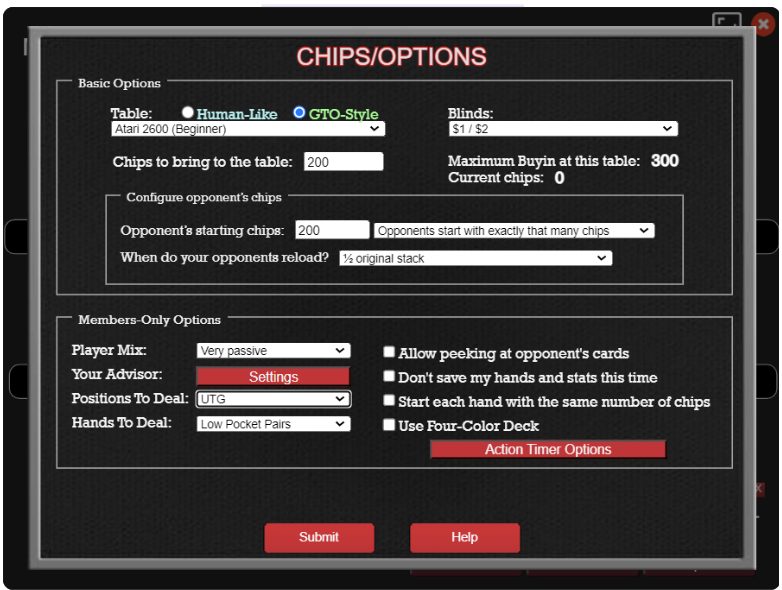Let me start by saying this: there are many exceptional poker players out there these day who own training sites, and I have no desire to challenge them all heads-up. Many of their lessons rely heavily on Game-Theory Optimal (GTO) play. But there are some things they are just dead wrong about when it comes to optimal play in low-stakes poker games.
“Learn Those GTO Charts”
First, only the absolute best players play close to GTO, and most people who try to play GTO play it very poorly. Unless you are playing in the highest stakes games, you can win more money by playing a non-GTO strategy.
I’m not saying the best players in the world don’t know this. But here’s the problem I have with their training material: it focuses too heavily on GTO play. In fact, the tools they advocate for (and frankly all the hottest GTO tools on the market today) teach you to play the GTO strategy and nothing else. So, am I saying you should abandon GTO principles? No, of course not. Will you win if you always play the GTO strategy? Absolutely. We even have GTO-Style bots here on APT to train against.
But how do you win the most? The answer to that is, by adapting your play to take advantage of your opponents’ tendencies.
Where Does GTO Go Wrong?
95% of poker players play in casual, smaller-stakes cash games and smaller buy-in tournaments. You’re probably one of those players. So this is the crux of where the practice of studying nothing but solvers goes astray. For 95% of all poker players, the best way to improve is by learning to beat typical human opponents. You know, like the ones you play against.
And, the way to learn to beat them isn’t by memorizing charts from the GTO solver. It’s by playing a lot of hands against a variety of real opponents. At AdvancedPokerTraining.com, you can play up to 500 hands an hour against life-like opponents. Everyone from weak passive players to those over-aggressive types. These virtual opponents on APT make the same mistakes your opponents are making, so you can learn to exploit them.
Using our game options, you can set up a table that plays like the games you play in – whatever that game may be. And you can play every game type – from cash game simulations, to tournaments as small as a Sit n’ Go or as large as the WSOP Main Event. All while getting expert AI advice designed to empower you to beat these real games.
There is NO FASTER WAY to learn to beat real poker players than here at APT. I’ve got 15 years and over 80,000 satisfied users from 175 countries to back it up. (Or, you can get back to memorizing those GTO charts…the choice is yours.)
“Don’t ever open-limp”
Some pros today have practically made a religion out of NEVER open-limping. By open-limping, we mean just calling the big blind as the first player to voluntarily put money in the pot. But once again, they are forgetting that 95% of all poker players play in passive low-stakes games where open-limping is much more profitable with certain hands.
These hands include small pairs and suited connectors. You have no desire to limit the field or start to build a pot with these hands. Nor do you want to discourage limping pre-flop overall. You want to keep the game nice and friendly, you know, where 5 players limp every hand. By doing a lot of pre-flop raising you’ll encourage other players to start raising more as well.
Your goal is to let in as many players as possible with these hands. You want lots of players who can make second-best hands and will give you a big chunk of their stack when you flop a monster. You want to keep the stack-to-pot ratio (SPR) big. Small pairs and suited-connectors love big SPRs. And what about when you miss the flop, which will be most of the time? You just fold, and you’re only out one big blind.
Don’t believe me? You can try it yourself here on APT. Choose an easy table with loose passive players. Using the game options, tell APT to only deal you small pocket pairs from Under-the-gun (UTG). Play 500 hands limping, and 500 hands open-raising, and compare your results.
Truthfully, I believe in a little open-limping in even higher stakes games, though the solvers don’t do it. While it does make it tougher to keep your range balanced and not give off any information, it certainly frustrates opponents who have studied nothing but solvers. A discussion of this is too much for this post, but Daniel Negreanu makes an excellent case for it in this video.
So before you head strictly down the GTO path, consider who you typically play with. And consider your goals for your game. Then use APT to sharpen your GTO AND your exploitative poker skills. You’ll be glad you did!



